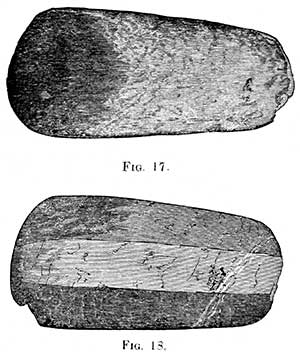CHAPTER V
IMPLEMENTS, ORNAMENTS, ETC.
Most of the minor relics of art discovered in the State of New York are such as are known to have been common amongst the Iroquois and other tribes which once occupied its territories. The character of these is so well known as to render unnecessary any detailed notice of the various articles obtained in the course of the explorations here recorded. A brief reference to the more remarkable specimens is therefore all which will be attempted.
Upon the site of every Indian town, as also within all of the ancient enclosures, fragments of pottery occur in great abundance. It is rare, however, that any entire vessels are recovered. Those which have been found, are for the most part, gourd-shaped, with round bottoms, and having little protuberances near the rim, or oftener a deep groove, whereby they could be suspended. A few cases have been known in which this form was modified, and the bottoms made sufficiently flat to sustain the vessel in an upright position. Fragments found in Jefferson county seem to indicate that occasionally the vessels were moulded in forms nearly square, but with rounded angles. The usual size was from one to four quarts; but some must have contained not less than twelve or fourteen quarts. In general there was no attempt at ornament; but sometimes the exteriors of the pots and vases were elaborately if not tastefully ornamented with dots and lines, which seem to have been formed in a very rude manner with a pointed stick or sharpened bone. Bones which appear to have been adapted for this purpose are often found. After the commencement of European intercourse, kettles and vessels of iron, copper, brass, and tin, quickly superseded the productions of the primitive potter, whose art at once fell into disuse. Pipes and various articles of clay, which may be denominated terra cottas, continued, nevertheless, to be made. The pipes of native manufacture were preferred, as they still are, to those of European or American production. After the introduction of tools, and as soon as the Indians became acquainted with foreign models, great improvement was made in their manufacture. The following examples will furnish very good illustrations of the forms of the Indian pipe.
Fig. 9 was found within an enclosure in Jefferson county, Plate IV. No. 4. It is engraved one half the size of the original. It is of fine red clay, smoothly moulded, and two serpents rudely imitated are represented coiling around the bowl, Bushels of fragments of pipes have been found within the same enclosure. Some appear to have been worked in the form of the human head, others in representations of animals, and others still in a variety of regular forms.
Fig. 10 was found within another enclosure in the same county. It differs from the first only in respect of size.
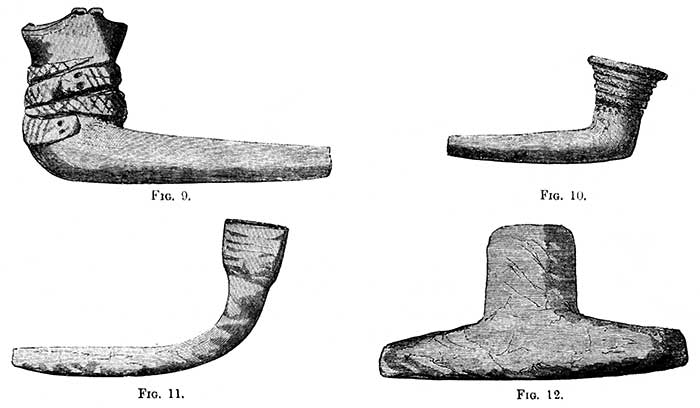
Fig. 11 was found on the site of an old Seneca town, in the town of Livonia, Livingston county. It resembles the other in shape, but is of darker color, and not so well burned. The difference to be observed between it and the others may be ascribed entirely to the difference in the clay composing it.
Fig. 12. This is a greatly reduced representation of an article of stone found near Mount Morris, in Livingston county, and now in the New York State Cabinet at Albany. It is composed of "soap stone," and in shape corresponds generally with the pipes of stone found in the mounds of the Mississippi Valley. If intended for a pipe, which seems most likely, it was never finished, as the cavity of the bowl is merely indicated. One or two pipes of stone of very nearly the same shape have been found in this vicinity, but in point of symmetry or finish they are in no way comparable to those of the mounds.
Some pipes of precisely the same material, and of identical workmanship with those found in the ancient enclosures, have been discovered in modern Indian graves, in Cayuga county. One of these, in the form of a bird, and having eyes made of silver inserted in the head, is now in possession of the author. Various articles of European or American manufacture were found in the same grave.
The most beautiful terra cotta which I found in the State, and which in point of accuracy and delicacy of finish is unsurpassed by any similar article which I have seen of aboriginal origin, is the head of a fox, of which Fig. 13 is a full-size engraving. The engraving fails in conveying the spirit of the original, which is composed of fine clay, slightly burned. It seems to have been once attached to a body, or perhaps to a vessel of some kind. It closely resembles some of the terra cottas from the mounds of the West and Southwest. It was found upon the site of an ancient enclosure in Jefferson county, in the town of Ellisburgh, near the beautiful village of Pierrepont Manor.
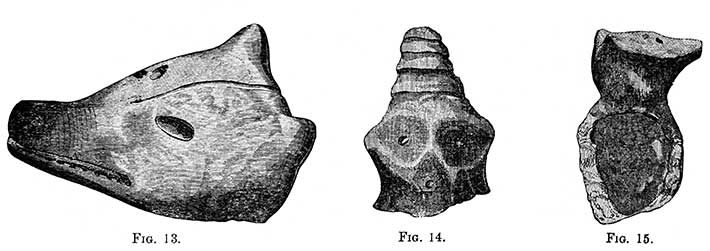
Figs. 14 and 15 were found upon the site of an abandoned Seneca village, in the town of Mendon, Monroe county. The spot is now known as the "Ball Farm," and is remarkable for the number and variety of its ancient relics. Vast quantities of these have been removed from time to time. Some of the miniature representations of animals found here are remarkable for their accuracy.
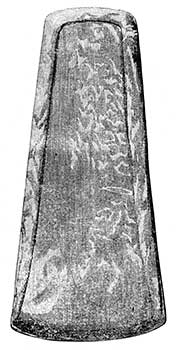 |
| Figure 16. Stone Axe. |
The stone axe or hatchet may be found from Cape Horn to Baffin's Bay. Specimens taken from the intervening localities can be distinguished from each other only by the difference of the materials of which they are composed. I have found them in Nicaragua precisely resembling those of New York. Little, therefore, need be said concerning them. Fig. 16 was obtained in the vicinity of an ancient work on the Susquehanna River, in Pennsylvania, near the New York State line. It is remarkable for its symmetry and size, and also for the manner in which it is hollowed upon the inner side. This last named feature is well indicated in the engraving.
Figs. 17 and 18 present a front and reverse view of a very fine stone axe, found in Livingston county, near Avon Springs. The material is of intense hardness, resembling porphyry. It is, nevertheless, worked with mathematical accuracy, and highly polished. The edge is very sharp. It is as fine a specimen of the Indian stone axe as ever fell under my notice.
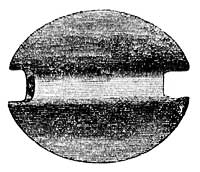 |
| Figure 19. Ornamental Hatchet. |
Fig. 19 is of a greenish colored slate, and resembles a kind of ornamental hatchet, made of delicate material, which is found at the South and West. It was obtained near Springport, Cayuga county. For examples of similar articles, the reader is referred to the first volume of the Smithsonian Contributions to Knowledge, p. 218.
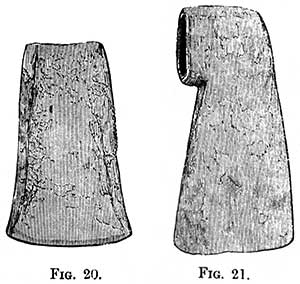 One of the most interesting relics which has yet been discovered
in the State is an axe of cast copper, of which Fig. 20
is a reduced engraving. The original is four inches long by
two and a half broad on the edge, and corresponds in shape with some of those of
wrought native copper, which_have been found in the mounds of Ohio. From the
granulations of the surface, it appears to have been cast in sand. There is no
evidence of its having been used for any purpose. Its history,
beyond that it was ploughed up somewhere in the vicinity of
Auburn, Cayuga county, is unknown. No opportunity has yet
been afforded of analyzing any portion, so as to determine
whether it has an intermixture of other metals. It appears to be
pure copper. An inspection serves to satisfy the inquirer that it
is of aboriginal origin; but the questions when and by whom
made, are beyond our ability to answer. There is no evidence
that the mound-builders understood the smelting of metals; on
the contrary, there is every reason to believe that they obtained
their entire supply in a native state, and worked it cold. The
Portuguese chronicler of Soto's Expedition into Florida, mentions copper
hatchets, and rather vaguely refers to a "smelting of copper," in a country
which he did not visit, far to the northward, called "Chisca."
The Mexicans and Peruvians made hatchets of copper alloyed
with tin. It would seem that this hatchet was obtained from
that direction, or made by some Indian artisan after intercourse
with the whites had instructed him in the art of working metals.
At present it is prudent to say that the discovery of this relic
is an anomalous fact, which investigators should only bear in
mind, Without venturing to make it the basis of deductions
or inferences of any kind.
One of the most interesting relics which has yet been discovered
in the State is an axe of cast copper, of which Fig. 20
is a reduced engraving. The original is four inches long by
two and a half broad on the edge, and corresponds in shape with some of those of
wrought native copper, which_have been found in the mounds of Ohio. From the
granulations of the surface, it appears to have been cast in sand. There is no
evidence of its having been used for any purpose. Its history,
beyond that it was ploughed up somewhere in the vicinity of
Auburn, Cayuga county, is unknown. No opportunity has yet
been afforded of analyzing any portion, so as to determine
whether it has an intermixture of other metals. It appears to be
pure copper. An inspection serves to satisfy the inquirer that it
is of aboriginal origin; but the questions when and by whom
made, are beyond our ability to answer. There is no evidence
that the mound-builders understood the smelting of metals; on
the contrary, there is every reason to believe that they obtained
their entire supply in a native state, and worked it cold. The
Portuguese chronicler of Soto's Expedition into Florida, mentions copper
hatchets, and rather vaguely refers to a "smelting of copper," in a country
which he did not visit, far to the northward, called "Chisca."
The Mexicans and Peruvians made hatchets of copper alloyed
with tin. It would seem that this hatchet was obtained from
that direction, or made by some Indian artisan after intercourse
with the whites had instructed him in the art of working metals.
At present it is prudent to say that the discovery of this relic
is an anomalous fact, which investigators should only bear in
mind, Without venturing to make it the basis of deductions
or inferences of any kind.
Fig. 21 is an example of the iron axe introduced among the Indians by the French. Thousands of these are found in the western counties of the State.
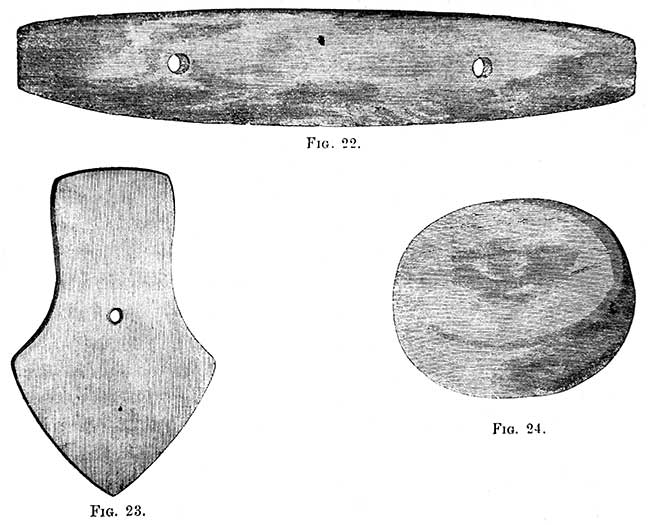
Figs. 22, 23, and 24 are selected by the author from the collection of relics made in the progress of these explorations, from their resemblance to relics of common occurrence in the mounds of the Mississippi Valley. Fig. 22 is almost identical in shape and material with some of the articles from the mounds, described on page 237 of the first volume of these Contributions. The same may be observed of Fig. 23. The material is the green, variegated slate, of which so many of the above named relics are composed. The first mound was found near Scottsville, Wheatland township, Monroe county; the second, near Springport, Cayuga county. Near this place also was found the disk, Fig. 24. It is of green slate, and corresponds entirely with those described on page 221 of the same volume with the preceding.

Fig. 25 is the point of a fish-spear, made of the ulna of the deer; found in Livingston county. Figs. 26 and 27 are of the same material, and were used as bodkins or for working clay; found in Jefferson county.
Besides these relics, quantities of beads of stone, bone, and shell, ornaments of many kinds and of various materials, as also implements of aboriginal, or European, or American fabric, are found all over the State, but in more abundance in the western counties. They are not of sufficient importance to merit a detailed notice, and are chiefly interesting as the relics of a race fast disappearing, and whose existence will soon be known to history alone. It is to be hoped that, however insignificant they may seem, they may be carefully preserved and treasured for public inspection, in places or institutions designated for the purpose.


